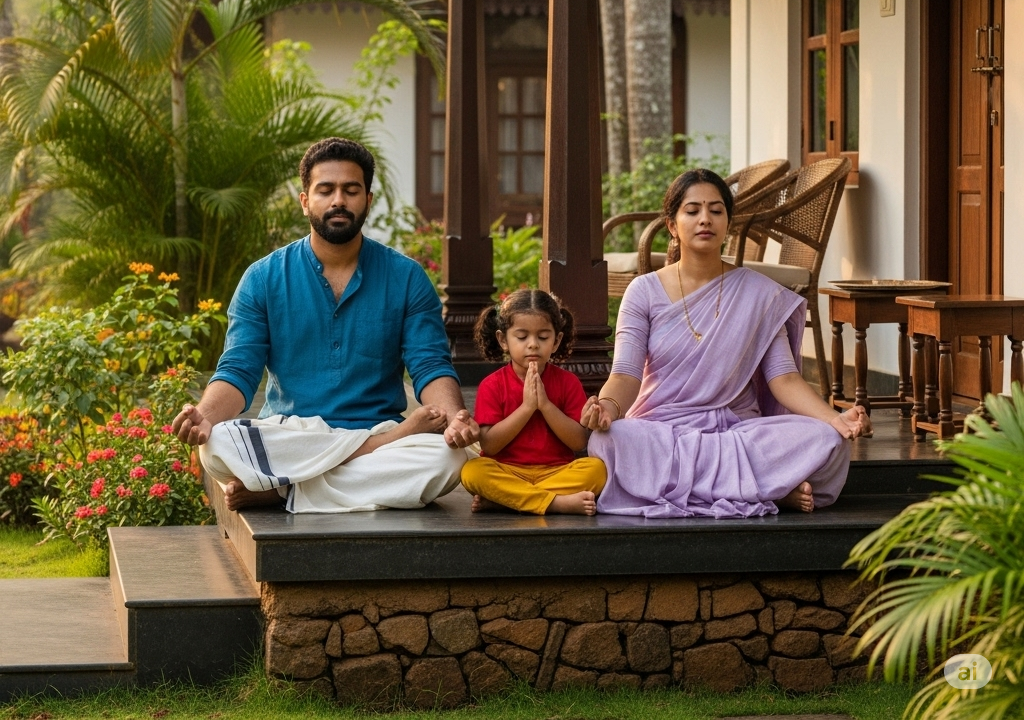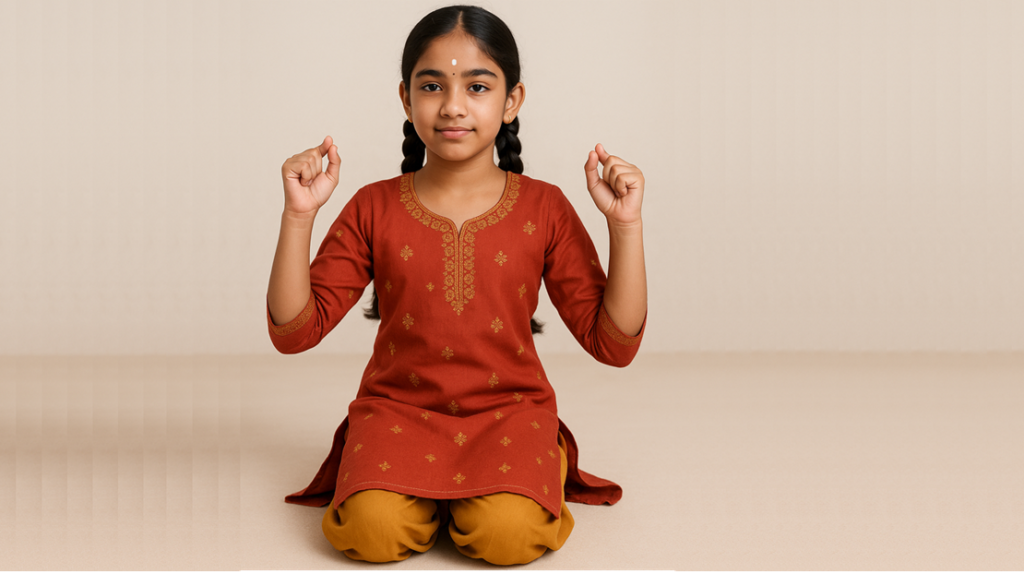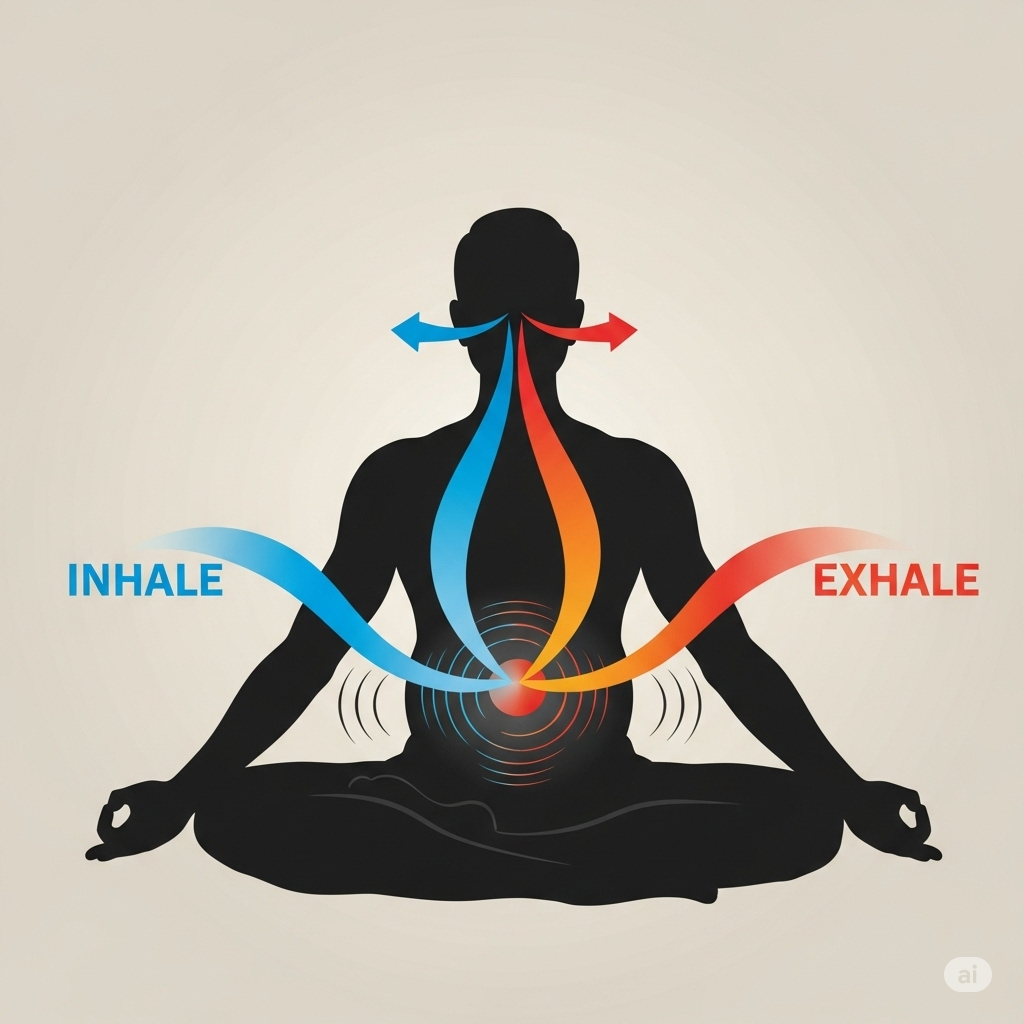What is prāṇāyāma?
Prāṇāyāma is an ancient Indian breath control technique that enhances health, wellness, and consciousness through regulation of the breath. We can easily embed this simple yogic breathing discipline into our daily lifestyle and routine. Check out our short video below that explains some of the nuances, before reading the text. This will enable greater understanding of the concept.
To understand the importance of prāṇāyāma, let us begin by understanding the process of breathing.
What happens when we breathe?

- We breathe without noticing it or being conscious of it. Hence, it is an involuntary action.
- While breathing in, we expand the chest and drop our abdomen, so that the lungs admit air from the atmosphere.
- The diaphragm, which forms the base of the thoracic cavity, moves down. This leads to a negative pressure within the lungs.
- Thus, the air drawn through the mouth and nostrils into the windpipe reaches the lungs.
- Similarly, during exhalation, the abdominal muscles contract, squeezing the abdominal viscera against the diaphragm.
- The diaphragm is pushed up, and the lungs get compressed. The air is full of carbon dioxide. Water vapour is forced out of the body through the nostrils.
Prāṇāyāma: Understanding lung capacity
Let us now understand the concept of lung capacity.
In each respiratory cycle, normal sedentary breathing does not fill or empty the lungs completely. Lungs have enormous reserve capacity and some of the critical aspects that determine lung function are:
- About 500 ml. of air circulates in each normal cycle of inhalation and exhalation. This is called Tidal Volume (TV).
- During exhalation, a further measure of one litre (1000 ml) of air can be forced out. This is called Expiratory Reserve Volumen(ERV).
- Similarly, during inhalation, a further measure of one litre (1000 ml) of air can be taken in. This is called Inspiratory Reserve Volumen(IRV).
- The lungs are not fully emptied even at this stage, and still hold about 1500 ml of air. This is called residual volume (RV), and this air cannot be forced out of the lungs.
- The lungs hold nearly five litres (5000 ml) of air, and this is called total lung capacity (TLC). Thus, it is the addition of residual volume (approx 1500 ml) and inspiratory volume (TV+ERV+IRV = approx 2500-3500 ml).
The maximum amount of air a person can take in or draw out after taking a deep breath is called vital capacity. It gives information about the strength of the respiratory muscles, the ability of the lungs, and also the size of the thoracic cage. Practicing prāṇāyāma is key to improving lung capacity and strengthening the respiratory system.
Understanding the relationship between breathing and health
Atmospheric air entering the lungs contains roughly 79% nitrogen, 20% oxygen, and traces of carbon dioxide. The body only uses oxygen out of all these components of air. In exchange, the body gives up carbon dioxide and water vapour.
The windpipe (trachea) divides into two bronchi. Each bronchus enters the lung on its side and divides itself into several branches called bronchioles. Further, the bronchioles divide and sub-divide themselves into fine terminal branches, and then, these terminate into respiratory bronchioles that hold minute air sacs called alveoli. Alveoli have a very thin lining surrounded by thin-walled capillaries that facilitate the exchange of gases. Though each alveolus is a very small microscopic structure, the number of alveoli in the lungs is enormous, providing an area of almost 50 square meters for the exchange of gases.
The process of diffusion is the exchange of gases in the alveoli, to and from the surrounding blood. Oxygen moves from the air to the blood. The hemoglobin present in the bloodstream absorbs oxygen. Carbon dioxide and water vapor diffuse from the blood to the alveolar air.
Absorption of oxygen and elimination of carbon dioxide and water vapor is the essence of respiration. This process goes on continuously in us, as long as we live, without requiring our attention. The body changes various elements of respiration, to suit the requirements of the body. Our nervous system governs all these changes.
This is how breathing impacts health. Now let us understand why it is important to learn breath regulation through prāṇāyāma.
How does prāṇāyāma enable us to manage change?
Breathing is not just the source of life; it is also the source of health and happiness.
- Incoming breath is the source of oxygen which is carried by the blood to all organs. This rejuvenates tissues and optimizes the oxidation process within the body.
- The outgoing breath removes carbon dioxide and water vapour, removing toxins and keeping the mucous balance in the lungs.
- Breathing changes with stress levels. When confronted with danger, our breathing becomes rapid and shallow. This is to compensate for enhanced awareness and increased demand for oxygen from muscles involved in the response.
- Finally, the balance in breathing between the left and right nostrils determines the balance between the left and right brain activity which affects the analytical and creativity capability and output of the person.
All the above factors impact our ability to live a wholesome life, in psychosomatic equilibrium. When we are able to regulate our breath, there is a visible improvement in our ability to manage change and challenges. The good news is that it can be brought under control by regulation and prāṇāyāma is the science of regulating it.
Importance of prāṇāyāma as the breath regulation practice
Every living tissue and cell requires a constant supply of energy to live. This energy is stored in the molecules of substances such as glucose, fructose, fatty acids, and amino acids, which are the end products of the process of digestion of food that we eat. The body releases energy through a process called oxidation. The process of oxidation requires oxygen. So, when there is no oxygen, the process of release of energy comes to a halt, and results in the death of that tissue.
In any fight/flight situation, such as while taking a long or high jump or lifting a heavy weight, etc., we automatically stop the breath. Also, when there is a sudden shock, or when there is complete absorption of the mind in something interesting, we stop breathing. This occurs because of the intensity of focus. Also, while we are resting, breathing automatically slows down, but when there is physical activity and an increased need for oxygen, breathing automatically becomes faster and deeper. Therefore, there is a definite linkage between breathing and the psychosomatic functioning of the body.
Disciplining the breathing process means increased absorption of oxygen, greater efficiency of the lungs, and also greater psychosomatic control over our responses. Thus, disciplined breathing enables us to meet all the challenges that come with change.
Prāṇāyāma is the practice of disciplined breathing. Prāṇāyāma is a very simple practice that goes a long way towards improving overall health.
Listen to Prime Minister Narendra Modi speak on the value of prāṇāyāma.
Internal Links: Dharma (conditioning), Stress and Situational Awareness, Prana, Asana overview 1, Asana Overview 2, Asana Focus or gazing, Hatha Yoga Pradeepika
External Links: Prana, Chakra, Pancha Tattva, Pancha Prana, Pancha Kosha, Nadi, respiration
Points to ponder on prāṇāyāma breathing
- Do you practice any form of aerobic breathing?
- What is your experience?
- Do you prepare yourself before starting exercises?
- What are the benefits you have experienced?
- Comment on breathing and health.
- Breathing and balanced thinking.
- What changes to your breathing have you observed when you are stressed?


